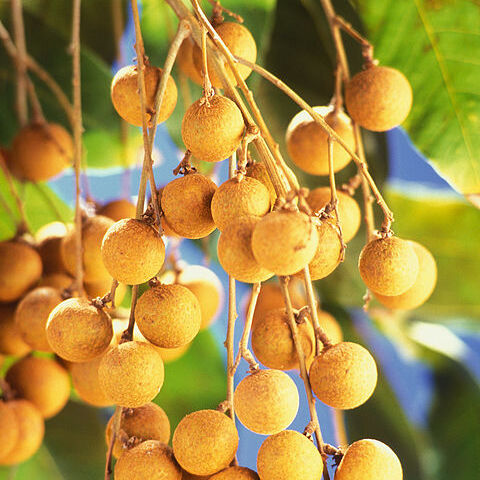Trees or shrubs, usually monoecious. Leaves paripinnate; leaflets opposite or subopposite, entire or serrate. Thyrses usually large, terminal, or fascicles, stellate or tomentose; bracts and bracteoles subulate, small. Flowers unisexual, actinomorphic. Calyx cupular; sepals 5, imbricate, stellate or tomentose. Petals 5 or 1-4, sometimes absent, usually spatulate or lanceolate, without scales. Disk acetabuliform. Stamens (male flowers) often 8, exserted; filaments hirsute; anthers ellipsoid. Ovary (female flowers) obcordiform, 2-or 3-lobed and 2-or 3-loculed, densely tuberculate, tufted stellate and tomentose on tubercles; ovules 1 per locule; style between ovary lobes; stigma 2-or 3-lobed. Fruit deeply lobed into 2 or 3 schizocarps, usually 1 or 2 developed; fertile schizocarp berrylike, subglobose, with small sterile schizocarps at base, pericarp leathery (crustaceous when dry), endocarp papery. Seeds subglobose or ellipsoid; testa leathery, smooth; hilum elliptic, slightly large; pseudotesta fleshy, embedding all or half of seed; embryo straight, cotyledons thick. 2n = 30.
Shrubs or trees, mostly monoecious. Indumentum of stellate or tufted and simple hairs. Leaves spirally arranged, paripinnate (1–7-jugate), rarely unifoliate; leaflets alternate or subopposite, entire or serrate-dentate, usually papillose below and with naked glands along midrib, rarely along margins. Inflorescence axillary or terminal, panicle-like; cymules sessile or stalked. Flowers unisexual, actinomorphic. Calyx cupular, usually deeply 5-lobed; lobes imbricate, hairy. Petals 5 or 0, rarely 6, mostly longer than sepals, oblong-obovate or ±oblanceolate, shortly clawed, hairy or with glabrous apex, papillate; scales absent. Disc complete, 5-lobed, hairy. Stamens 6–8 (–10); filaments usually hairy. Ovary sessile, 2-or 3-lobed; ovule 1 per locule; stigma 2-lobed. Fruit 1-(or 2)-lobed, globular or broadly ellipsoid; lobes indehiscent, warty or sometimes smooth or spiny. Seed dark or blackish brown, shiny, enveloped by fleshy translucent white aril.
Trees or shrubs with simple or stellate hairs. Stipules wanting. Leaves alternate, paripinnate, rarely unifoliolate; rachis ending in a distal process (rudimentary leaflet); leaflets serrate or entire. Inflorescences distal or less often axillary, paniculate thyrses with flowers in lateral dichasia. Flowers actinomorphic, functionally unisexual (falsely polygamous); calyx of 5-6, imbricate sepals that are connate at base or free; petals 5(6) or wanting, without appendages; disc annular, 5-lobed, pubescent; stamens (6-) 8 (-10), anthers dorsifixed; ovary 2(3)-carpellate, with a single ovule per carpel; style filiform, with 2-3 stigmatic spreading lobes. Fruits of 1(2) indehiscent, or tardily dehiscent, warty, smooth, or spiny mericarps Seeds with a thin, translucent-white, fleshy aril around the hilum.

